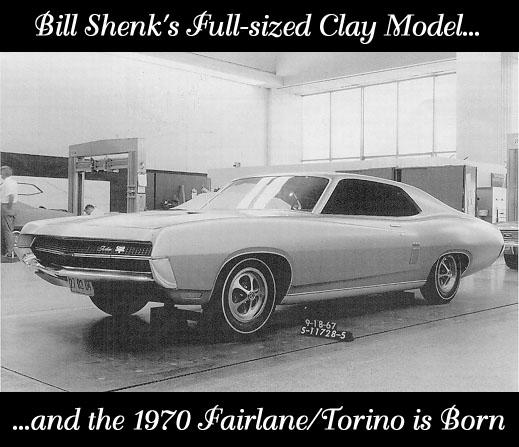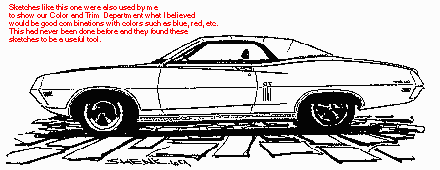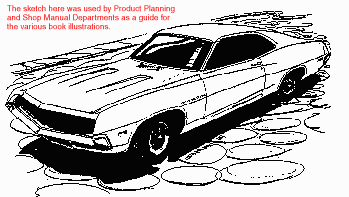The Birth of the 1970 Ford Fairlane/Torinoby Bill Shenk
This is the story of the 1970/71 Torino. The exterior design of that model line started with me, and it ended with me. I was the sole stylist for the design, and this is my story of what was and what can "never be again." You see, in 1967, several incidents occurred that placed me in the right place at the right time. But let me back up for just a moment. I had been a stylist with Ford since March 12, 1962. Between that time and 1967, I was designing hub caps, wheel covers, and 'C' pillar ornaments. In fact one of my 'C' pillar circular ornaments ended up on the 1967 Falcon Futura. But unknown to most people, that ornament was designed right after lunch one Tuesday. The designing of that ornament began the sequence of events leading to the 1970 Torino. You see, I always brought my
lunch to work, and I really liked Oreo cookies. This particular Tuesday,
my boss came over immediately after lunch, and said that Joe Oros,
director of Ford exterior studio, wanted to go over all the design items
for that Friday. Since my boss had not given the Falcon ornament job
out, I got it. With 2 hours to make some type of design--anything for
the initial discussion was okay, just so long as it had lots of
pizzazz--I simply took this Oreo cookie I had not eaten, slid it apart,
and then sprayed the heck out of it with silver and flat black Krylon.
This was then dabbed with Klennex to really get a chromed top look and
the black to appear as "depth" of detail. Joe Oros asked about the ornament as a passing comment, assuming it was all prepared. My boss piped in and also asked me where it was. I pointed to the driver side of the 2-door Falcon roof area. They walked over, and Joe just said, "That's the best ornament I've seen. How did you make it in three dimensions?" Well, we talked several minutes, and then my boss asked the same question so he could get Joe away from me and out of the studio. I then simply went over to the car, took the ornament off, and slowly snapped it in half. Joe flipped and did a double take at both me and my boss. Then he said, "Make another one and we show it, but for approval, not for direction." Smiling, Joe walked out. My boss was astonished and was taken aback by my solution to the problem. I tell about this incident for several reasons. The most important in that back in those styling days anything went, so long as it could be built and looked different. Only one man had the say on what went on a car, any car, from a Falcon to a Ford Thunderbird, and that man was Joe Oros. Several things happened to me
soon after the Oreo incident. First, I was promoted to senior designer.
(I had the distinction of having spent the shortest time ever as an
"A" Designer before being promoted to "Senior
Designer." Normally, a new hire coming directly from art center
school spent the first two years in one of four different design
studios. During this time he was evaluated by different directors for
"potential and styling ability." Today, this phrase is called
"problem solving creativity." If you made the cut as a
stylist, you were given the title of "B" Illustrator, as I was
in 1962. The promotion route was then to "A" Illustrator,
"B" Designer, "A" Designer, and finally "Senior
Designer." Even back then, being promoted to Senior Designer in
five years was just not done.) The second thing to happen
occurred about two weeks after my promotion--I was transferred to the
Mercury Exterior Studio. I later found out that the transfer occurred
because the Mercury director Buzz Grissinger had heard about the
"Oreo incident" and wanted me in his department. Soon after I
arrived, my immediate manager, Mr. Dardin, suffered a heart attack and I
took charge of department assignments. This is where I found myself as
the 1970 Torino and Montego were about to be created. The process began
with an assignment by Product Planning about early April 1967 to begin
work on coming up with a new Montego. Ford was to also do a new Torino. My design executive was Mr. Bob Koto--a splendid and likable guy. He would create a scale model of what he felt the new "this or that" should look like to grasp the initial theme direction and to show his concept to Gene Bordinat. This was always Bob Koto's method, and everyone accepted it as a normal matter of business, including me. All of us were doing sketches
and having real fun going "way-out," stretching the design
envelope. Most sketches were comfortable, some stupid, some very well
liked, and some that we each fell in love with. My personal styling
theme had been the same for several years. I loved aircraft and had
gotten a job at Hughes Aircraft after running out of money for more
automobile designing art center school in 1957. I spent three years with
Hughes, mainly on "F-102" and "F-106 Convair contract
work. This was the era of "Area Rule,"
"Compressibility," "Mach I," and "Delta
Wings." So some of my personal likes rubbed off into my sketches at
the Ford styling center, and Ford and Mercury Exterior Studios. During early 1967, I took it
upon myself to create my own personal list of directions to guide my
sketches. Thus, I had a personal design direction goal to work from. I
used a "SBB" (styling blackboard), which was a 7 foot high by
24 foot long vertical blackboard used for sketches, etc. There were ten
to fifteen of these large blackboards in the design studios and these
were always covered with each stylist's work. With five to eight
stylists in each department doing about five to six rendering and
sketches per day, the boards were covered by the end of two weeks with
every type and size, color and view, of all sorts of car designs. We
would have "design reviews" internally with Buzz Grissinger,
and select losers and hopefuls. Then we would start all over again to
reorganize the board into types, shapes, model sizes, etc. All the
while, Bob Koto was still scale modeling his Montego on his walnut desk
in his private office. He did his thing, we did ours. Several internal reviews later
I had one (just one) sketch picked out from over one hundred of mine
which had a rakish front fender line that disappeared into the door
panel and a rear fender top edge becoming the "wide hood"
character. The top area had a long, sloping, semi-fast backlite, and the
plan view showed off the "coke bottle" in and out form which
gave the squeeze on the area of the door (Corvair aircraft "area
rule"). I wanted length, but with some start and stop flowing lines
to the long bodyside. This, then, was the birth of the "coke
bottle" bodyside theme. Then Bob Koto told me to do a Ford, not a
Mercury. I was given only four clay modelers to do an entire exterior. This usually requires 12, sometimes more, but since other Mercury programs were going on at the same time, and Bob Koto was the boss, he told me that all I was working on was a "back-up" full size model to show the brass another Fairlane theme, and that his design was the "real" Montego theme. I know then that I had no real sponsor for my design, only a gesture of support because it was expected that the Mercury studio would contribute to the Fairlane styling competition. So I did my thing. I gave each modeler one job. One had the front, back to the "B" pillar. One had taillights to the "B" pillar. Another had the roof and glass. And the final clayman had both rockers and lower bodyside. I did the full size tape drawing, sections, and a scale model. I also had a great resident engineer, Bob Volappi, who reinvented the old body engineering solutions that continued to give my clay the new solution uniqueness that Bob Koto could not understand, even as it was happening. This was the first time an engineer stayed after-hours to redefine the rules and Ford design standards for wheel opening minimum requirements. That kind of creative engineering was unheard of, particularly for a styling department to propose new solutions for such things as wheel clearances. This went for two-sided taillight optics, called "concentric," as well. That's when both sides of the red lens have an optic pattern, thus allowing the backcan to go only half as deep into the trunk area. We found out later that Planning and Marketing loved our new wheel openings as the new, bigger F-70x15" tires could fit. Planning and Marketing overruled Body Engineering that year, and many old and long accepted engineering rules were changed by one engineer, four clay modelers, and one senior designer. I could go on and on, but the
crowning touch was the very first official show in the courtyard by the
Product Planning people for their boss, Lee Iacocca. You might recall
that he was the Vice President of Planning back then, and all approvals
went through him and Gene Bordinat. Well, since I had been told that my
efforts were only for backup support, and since I had been left on my
own, I made the decision to have my model di-noc done in a straight
shade of bright red. (Di-noc is a 54" high by 200 feet long, rolled
up decal with hot water peel-off backing. Very pliable, the clay
modelers apply it by wetting the clay model, then simply laying the
di-noc on the clay and squeegeeing out the all the water trapped between
the two. It takes about 6 hours for the di-noc to dry enough to be
handled.) I should mention that of the 12 full -sized clays seen by Lee
Iacocca at that first outside show, all of them except mine, the
"back-up" theme, were in silver di-noc. Nobody in the styling
building could believe that anyone would break the "silver di-noc
rule." The modeling is never sufficient for real good surfaces, and
besides, the unequal competition presented by an unapproved color was a
definite "no-no." Thus started a very fast emotional ride for
me. We all peered through the tall,
one-way, studio-to-courtyard glass, and very slowly, after 15 to 20
minutes, the Millwrights, who pull all the 15,000 pound full size clays,
began to empty-out the courtyard. After about 1 to 2 hours, there were
only four clays left--three silver and one red. The red went to the
center courtyard turntable. Lots of hands pointed here, there, words
were spoken (unheard by us), and slowly the last three silver models
were pulled out of the area. I was beside myself! It was like a dream. I couldn't believe it. The red car, the only one left, was mine. After another hour, the red car was pulled back into the Mercury studio; very rapidly, the studio filled with other stylists and many of the planners. I had the model put back into the same "bridge for use" where it was initially clayed. I was asked to move it into the studio center bridge, but said no. I wanted it in the same bridge because the points were already correctly established. I also wanted the same modelers, and no more, to continue the work on the model. Bob Koto was beside himself and
tried to persuade Buzz Grissinger to let him take over the model, but he
said no. Buzz was the boss, and I knew he was my real boss. He simply
came over and said, "Fine job, but Bill, you know that for the next
show everyone will be after your car and after your design. I want these
doors locked at all times, and nobody but who You need comes in,
understood? Oh, by the way, the decision made today was that the lead
model will be the Ford Torino, so whatever you do, this is now the Ford
Torino, not the Mercury Montego." Then Buzz walked out. There were only three additional official shows for Lee Iacocca. Never before, or since, have there been so few reviews of a car at design center. Mr. Iacocca just fell in love with the design and the color. He only said one thing to Gene Bordinat, "Go back and tell Shenk, don't touch the car." This was passed on to me, but when Buzz Grissinger relayed the same message I said, "Great, but I will be touching the car." He smiled, turned, and left. I continued to touch, revising
the taillight details, adding the hide-away headlights we got from
planning, adding slightly to the plan curve, and sweetening the hood
crown. I also added a new hood for the "high series" and even
worked out the vinyl roof design. All this was done on this same red
2-door hardtop clay model. The vinyl roof color had never been done on a
full size clay, but I did it, and in white. I also put a white tape
stripe on the red body. That was the configuration for the fourth and
final show. And that is how it was back in 1967. The 1970 Torino grew out of a combination of free-wheel styling, constrained time requirements, and accidental occurrences that would never happen again at Ford styling during the next 26 years I was there. I retired in January 1993, after 31 years of drawing cars. Yes, there were many other vehicles I designed, but this was the way it was normally done. (Alas, never before and never again would it happen.) So, this is how one of our club Fairlane/Torino models was born. I have written this article in hopes that all of us will continue to find out more about the cars we own. Today, more and more, the "real automobile" is rapidly disappearing, along with it, as a statement of who we are. In its place are cars more like simple appliances, to be discarded after 30,000 miles or 2 years, whichever comes first. Keep looking around, call your club friends, and continue to push the dial for "classic cars." Maybe there will be a more from 1975 and on. Let's hope so.
|



